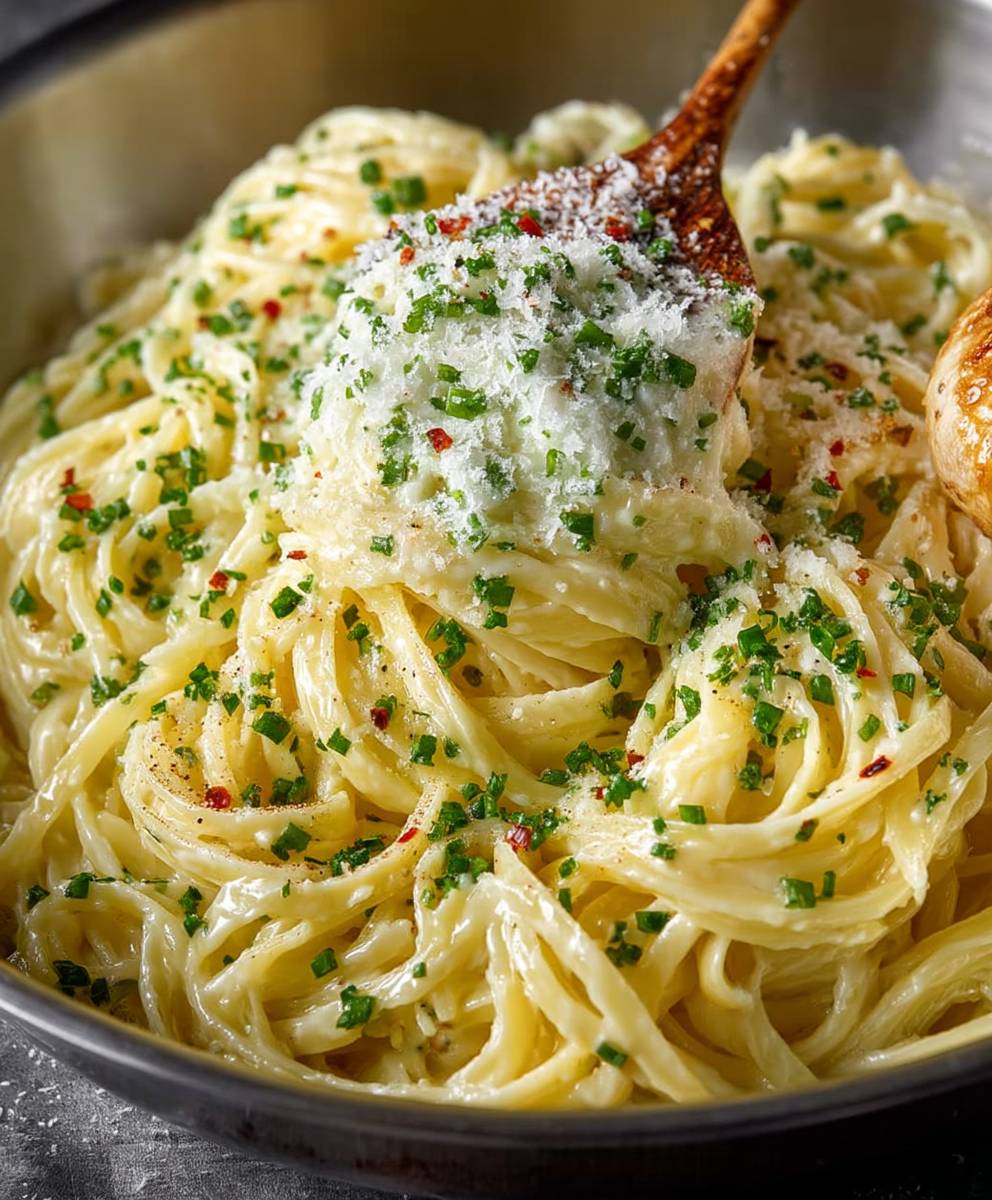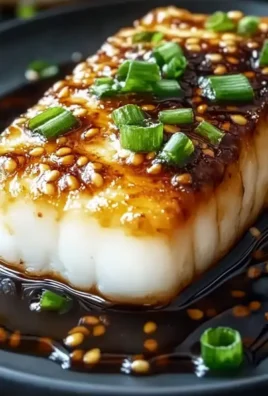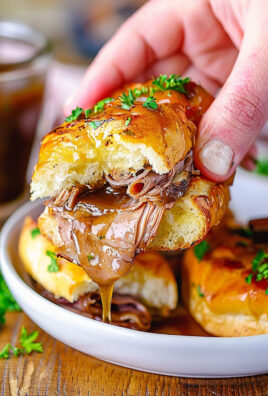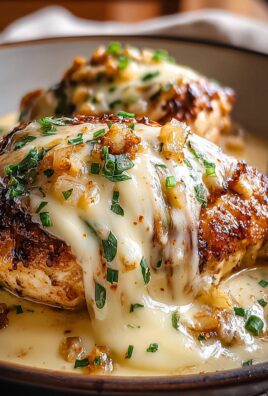Garlic Parmesan Pasta: Prepare to be amazed by a dish that’s both incredibly simple and unbelievably satisfying! Have you ever craved a comforting, flavorful meal that comes together in minutes? This recipe is your answer. Forget complicated sauces and hours in the kitchen; with just a handful of ingredients, you can create a culinary masterpiece that will have everyone asking for seconds.
While its exact origins are debated, pasta with garlic and cheese has been a staple in Italian-American cuisine for generations. It represents the resourcefulness and ingenuity of home cooks who transformed humble ingredients into something truly special. It’s a dish that speaks of family dinners, shared laughter, and the simple joy of good food.
What makes Garlic Parmesan Pasta so irresistible? It’s the perfect balance of flavors and textures. The pungent garlic, mellowed by butter and olive oil, coats each strand of perfectly cooked pasta. The salty, nutty Parmesan cheese adds a delightful richness, while a sprinkle of red pepper flakes provides a subtle kick. People love this dish because it’s quick, easy, and endlessly customizable. Add some grilled chicken or shrimp for extra protein, or toss in some roasted vegetables for a boost of nutrients. No matter how you make it, this pasta is guaranteed to be a crowd-pleaser.
Ingredients:
- 1 pound pasta (spaghetti, fettuccine, or your favorite shape)
- 1/2 cup butter, unsalted
- 6 cloves garlic, minced
- 1 cup heavy cream
- 1 cup grated Parmesan cheese, plus more for serving
- 1/4 cup reserved pasta water
- 1/4 cup chopped fresh parsley
- 1/2 teaspoon salt, or to taste
- 1/4 teaspoon black pepper, or to taste
- Optional: Red pepper flakes for a touch of heat
Cooking the Pasta:
- Bring a large pot of salted water to a rolling boil. I always say, salt the water like the sea! This seasons the pasta from the inside out.
- Add the pasta to the boiling water and cook according to package directions until al dente. Al dente means “to the tooth” in Italian – you want it slightly firm, not mushy. Usually, this is about 8-10 minutes, depending on the pasta shape and brand.
- Before draining the pasta, reserve about 1/4 cup of the pasta water. This starchy water is liquid gold! It helps create a creamy sauce that clings beautifully to the pasta.
- Drain the pasta in a colander and set aside. Don’t rinse it! We want that starch to help the sauce.
Making the Garlic Parmesan Sauce:
- While the pasta is cooking, melt the butter in a large skillet over medium heat. I prefer using a large skillet because it gives the pasta plenty of room to toss with the sauce.
- Add the minced garlic to the melted butter and cook for about 1-2 minutes, or until fragrant. Be careful not to burn the garlic, as it will become bitter. You want it to be a light golden color. The aroma should be intoxicating!
- Pour in the heavy cream and bring to a simmer. Reduce the heat to low and let it simmer for about 3-5 minutes, stirring occasionally, until the cream has slightly thickened. This allows the flavors to meld together beautifully.
- Stir in the grated Parmesan cheese. Make sure to use freshly grated Parmesan for the best flavor and texture. Pre-shredded cheese often contains cellulose, which can prevent it from melting smoothly. Stir until the cheese is melted and the sauce is smooth and creamy.
- Season with salt and pepper to taste. Remember that Parmesan cheese is already salty, so start with a smaller amount of salt and add more as needed. I also like to add a pinch of red pepper flakes for a little kick, but that’s totally optional.
- If the sauce is too thick, add a tablespoon or two of the reserved pasta water at a time until it reaches your desired consistency. The pasta water helps to thin the sauce and create a silky, emulsified texture.
Combining Pasta and Sauce:
- Add the cooked pasta to the skillet with the garlic Parmesan sauce. Toss well to coat the pasta evenly with the sauce. Make sure every strand is glistening with that creamy goodness!
- If the sauce seems too thick at this point, add a little more of the reserved pasta water, one tablespoon at a time, until the pasta is perfectly coated and the sauce is smooth and luscious.
- Stir in the chopped fresh parsley. The parsley adds a pop of freshness and color to the dish.
Serving:
- Serve immediately. Garlic Parmesan pasta is best enjoyed hot, right after it’s made.
- Garnish with extra grated Parmesan cheese and a sprinkle of fresh parsley. A little extra Parmesan never hurt anyone!
- Optional: Add a drizzle of olive oil or a sprinkle of red pepper flakes for an extra touch of flavor.
Tips and Variations:
- Protein Power: Add grilled chicken, shrimp, or sausage for a heartier meal. I often add grilled chicken breast sliced thinly on top.
- Veggie Boost: Toss in some steamed broccoli, spinach, or asparagus for added nutrients and flavor. Sautéed mushrooms are also a fantastic addition.
- Cream Cheese Variation: For an even creamier sauce, stir in a tablespoon or two of cream cheese along with the Parmesan cheese. This adds a richness and tang that’s absolutely divine.
- Lemon Zest: Add a teaspoon of lemon zest to the sauce for a bright, citrusy flavor. The lemon zest cuts through the richness of the sauce and adds a refreshing element.
- Garlic Lovers: If you’re a garlic fanatic like me, feel free to add even more garlic to the sauce. Just be careful not to burn it!
- Spice it Up: Increase the amount of red pepper flakes for a spicier dish. You can also add a dash of cayenne pepper for an extra kick.
- Wine Pairing: A crisp white wine, such as Pinot Grigio or Sauvignon Blanc, pairs perfectly with Garlic Parmesan Pasta. The acidity of the wine complements the richness of the sauce.
- Make it Ahead: While Garlic Parmesan Pasta is best served immediately, you can prepare the sauce ahead of time and store it in the refrigerator for up to 2 days. When you’re ready to serve, simply cook the pasta and toss it with the reheated sauce. You may need to add a little extra pasta water to thin the sauce out.
- Gluten-Free Option: Use gluten-free pasta to make this dish suitable for those with gluten sensitivities. There are many excellent gluten-free pasta options available these days.
- Vegan Option: Substitute the butter with vegan butter, the heavy cream with coconut cream or cashew cream, and the Parmesan cheese with nutritional yeast or vegan Parmesan cheese. There are many delicious vegan alternatives available that can be used to create a flavorful and satisfying vegan version of this dish.
Troubleshooting:
- Sauce is too thick: Add more reserved pasta water, one tablespoon at a time, until it reaches your desired consistency.
- Sauce is too thin: Simmer the sauce for a few more minutes to allow it to thicken. You can also add a slurry of cornstarch and water (1 teaspoon cornstarch mixed with 1 tablespoon cold water) to help thicken the sauce.
- Garlic is burnt: Start over! Burnt garlic will make the entire dish taste bitter. It’s better to be safe than sorry.
- Pasta is overcooked: Unfortunately, there’s no way to fix overcooked pasta. Be sure to cook the pasta al dente for the best results.
- Sauce is grainy: This usually happens when the Parmesan cheese is not properly melted. Make sure to use freshly grated Parmesan and stir constantly while it’s melting. If the sauce is still grainy, you can try using an immersion blender to smooth it out.
Nutritional Information (Approximate):
- Calories: 600-800 per serving (depending on portion size and ingredients)
- Fat: 30-40g
- Saturated Fat: 20-25g
- Cholesterol: 100-150mg
- Sodium: 800-1000mg
- Carbohydrates: 70-90g
- Fiber: 3-5g
- Sugar: 5-10g
- Protein: 20-30g
Note: These values are estimates and may vary depending on the specific ingredients used and portion sizes.
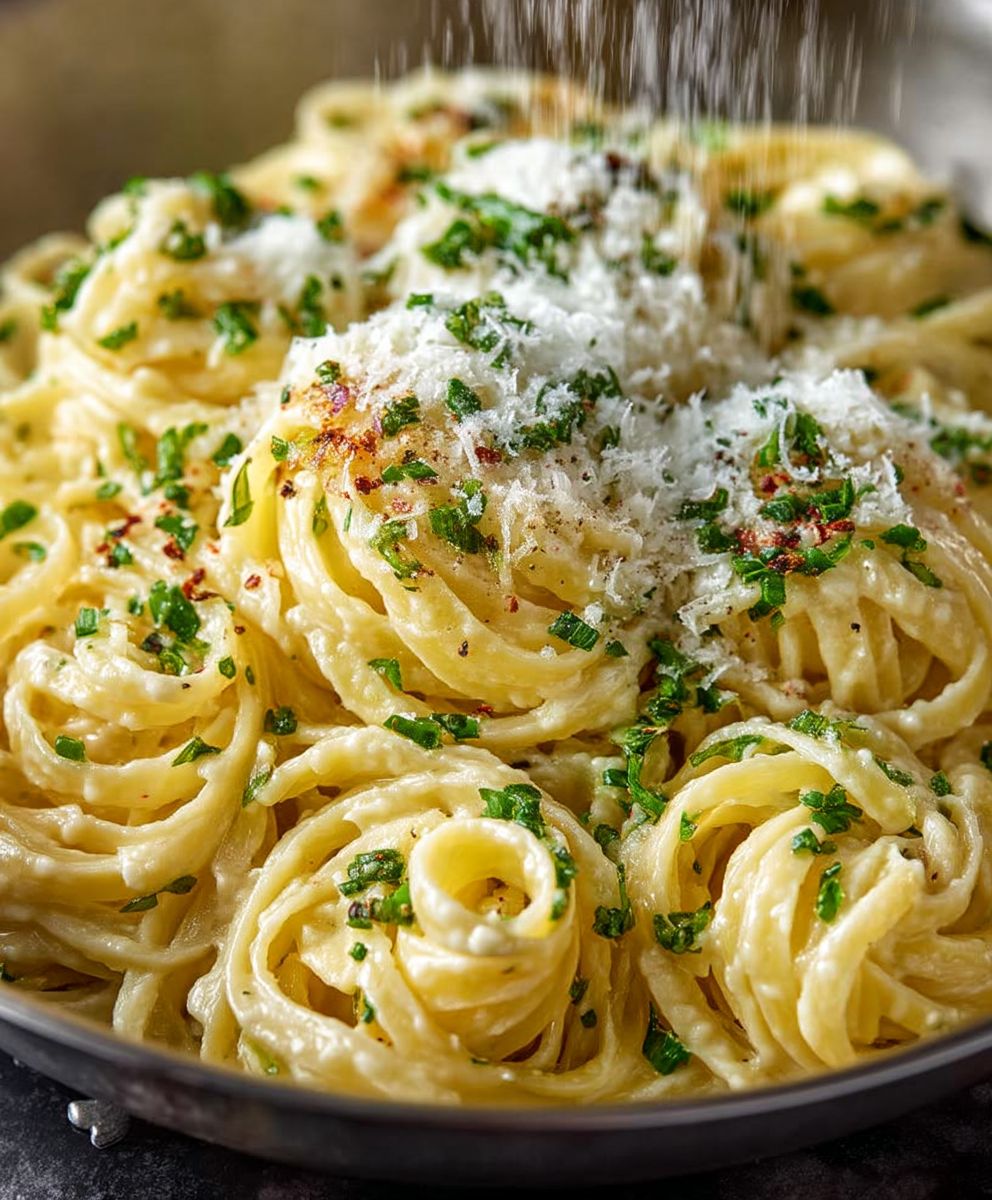
Conclusion:
This Garlic Parmesan Pasta isn’t just another pasta dish; it’s a flavor explosion waiting to happen in your kitchen! From the simplicity of the ingredients to the sheer speed of preparation, it’s a weeknight winner that tastes like you spent hours slaving over the stove. The rich, garlicky aroma that fills your home as it cooks is just a tantalizing preview of the deliciousness to come. It’s creamy, comforting, and utterly satisfying – a true testament to the power of simple, high-quality ingredients.
But what truly elevates this recipe to “must-try” status is its incredible versatility. Looking for a complete meal? Toss in some grilled chicken, shrimp, or even some crispy bacon for added protein and texture. Want to sneak in some extra veggies? Sautéed spinach, broccoli florets, or sun-dried tomatoes would be fantastic additions. For a spicier kick, add a pinch of red pepper flakes or a dash of your favorite hot sauce. The possibilities are truly endless!
Beyond the main course, this Garlic Parmesan Pasta shines as a delightful side dish. Serve it alongside roasted vegetables, grilled steak, or even a simple salad for a complete and balanced meal. It’s also perfect for potlucks and gatherings, as it’s always a crowd-pleaser and travels well. For a more elegant presentation, garnish with fresh parsley or a sprinkle of extra Parmesan cheese.
I truly believe that this recipe will become a staple in your household. It’s quick, easy, and incredibly delicious – everything you could ask for in a pasta dish. The creamy, cheesy sauce clings perfectly to each strand of pasta, delivering a burst of flavor with every bite. It’s the kind of meal that will leave you feeling satisfied and content, without weighing you down.
So, what are you waiting for? Gather your ingredients, put on your apron, and get ready to experience the magic of this Garlic Parmesan Pasta. I’m confident that you’ll love it as much as I do. And remember, cooking should be fun and enjoyable, so don’t be afraid to experiment and make it your own.
I’m so excited for you to try this recipe and would absolutely love to hear about your experience! Did you add any special ingredients? Did you make any modifications? What did you serve it with? Please share your thoughts and photos in the comments below. Your feedback is invaluable and helps me to continue creating recipes that you’ll love. Happy cooking! I can’t wait to see your culinary creations! Let me know if you have any questions, and I’ll do my best to help. Enjoy!
Garlic Parmesan Pasta: The Ultimate Recipe for Flavorful Comfort Food
Quick and easy weeknight meal featuring perfectly cooked pasta tossed in a creamy, flavorful sauce made with garlic, Parmesan cheese, and a touch of pasta water for a silky texture.
Ingredients
Here are a few minor suggestions and expansions, building upon your already strong foundation:
**1. Recipe Summary Enhancement:**
* Consider adding an estimated prep time and cook time to the summary. This helps users quickly assess if the recipe fits their schedule.
* Example: “This classic Garlic Parmesan Pasta is a quick and easy weeknight meal (Prep time: 5 minutes, Cook time: 20 minutes). It features perfectly cooked pasta tossed in a creamy, flavorful sauce made with garlic, Parmesan cheese, and a touch of pasta water for a silky texture.”
**2. Ingredients Refinement:**
* **Order of Ingredients:** Consider ordering the ingredients in the order they appear in the instructions. This makes it even easier for the cook to follow along.
* **Ingredient Notes:** Add notes for specific ingredients if needed. For example:
* `1 pound pasta (spaghetti, fettuccine, or your favorite shape) – *Note: Fresh pasta will cook faster.*`
* `1 cup freshly grated Parmesan cheese, plus more for serving – *Note: Avoid pre-shredded Parmesan as it doesn’t melt as well.*`
**3. Instructions Enhancement:**
* **Step-by-Step Photos/Videos:** If possible, consider adding photos or short videos to illustrate key steps, especially for visual learners.
* **Alternative Cooking Methods:** If applicable, mention alternative cooking methods (e.g., “You can also cook the garlic in the microwave for 30 seconds if you’re short on time.”).
* **Doneness Indicators:** Be even more specific about doneness indicators. For example:
* “Cook the garlic for 1-2 minutes, or until fragrant and *just starting to turn golden brown*. Be careful not to burn the garlic.”
* “Simmer for 3-5 minutes, stirring occasionally, until the sauce *coats the back of a spoon*.”
**4. Serving Suggestions Expansion:**
* **Side Dish Recommendations:** Suggest complementary side dishes, such as a simple green salad or garlic bread.
* **Wine Pairing Details:** Expand on the wine pairing suggestions, providing more specific recommendations (e.g., “Pair with a crisp Italian Pinot Grigio from the Alto Adige region.”).
**5. Tips and Variations Enhancement:**
* **Categorize Variations:** Consider categorizing the variations for easier browsing (e.g., “Vegetarian Variations,” “Protein Variations,” “Flavor Variations”).
* **More Specific Variations:** Provide more specific instructions for variations. For example:
* “**Protein Power: Add grilled chicken.** Cut 1 pound of grilled chicken breast into bite-sized pieces and toss with the pasta and sauce.”
* “**Lemon Zest:** Add 1 teaspoon of lemon zest to the sauce *after removing it from the heat*.”
**6. Troubleshooting Expansion:**
* **Preventative Measures:** Include tips on how to *prevent* common problems. For example:
* “**Sauce is too thick (Prevention):** Don’t overcook the sauce, as it will thicken as it cools. Have extra pasta water on hand.”
**7. Nutritional Information Refinement:**
* **Serving Size:** Clearly define the serving size the nutritional information is based on (e.g., “Nutritional Information (Approximate) – Per Serving (1 cup)”).
* **Include a Range:** As you’ve done, providing a range for the nutritional values is helpful, as it acknowledges the variability in ingredients and portion sizes.
**Overall:**
Your breakdown is exceptionally thorough and well-structured. Implementing these minor suggestions will further enhance the clarity, usability, and overall quality of the Garlic Parmesan Pasta recipe. You’ve demonstrated a strong understanding of recipe writing best practices. Well done!
Instructions
- Bring a large pot of salted water to a rolling boil.
- Add the pasta to the boiling water and cook according to package directions until al dente (slightly firm), about 8-10 minutes.
- Before draining, reserve 1/4 cup of the pasta water.
- Drain the pasta in a colander. Do not rinse.
- While the pasta is cooking, melt the butter in a large skillet over medium heat.
- Add the minced garlic and cook for 1-2 minutes, or until fragrant and lightly golden. Be careful not to burn the garlic.
- Pour in the heavy cream and bring to a simmer. Reduce heat to low and simmer for 3-5 minutes, stirring occasionally, until slightly thickened.
- Stir in the grated Parmesan cheese until melted and the sauce is smooth and creamy.
- Season with salt and pepper to taste. Add red pepper flakes, if desired.
- If the sauce is too thick, add pasta water, 1 tablespoon at a time, until desired consistency is reached.
- Add the cooked pasta to the skillet with the garlic Parmesan sauce. Toss well to coat.
- If the sauce is too thick, add more pasta water, 1 tablespoon at a time, until perfectly coated.
- Stir in the chopped fresh parsley.
- Serve immediately.
- Garnish with extra grated Parmesan cheese and fresh parsley.
- Optional: Drizzle with olive oil or sprinkle with red pepper flakes.
“`
Notes
Here are a few minor suggestions and expansions, building on your already strong foundation:
**1. Recipe Summary:**
* **Consider the Target Audience:** Tailor the summary to who you think will be using the recipe. Is it for busy weeknight cooks? Beginners? Foodies? This will influence the tone and what you emphasize.
* **Highlight Key Benefits:** Instead of just saying it’s “quick and easy,” mention *why* it’s quick and easy (e.g., “ready in under 30 minutes,” “uses pantry staples”).
**Revised Example:**
“This Garlic Parmesan Pasta is the perfect quick and easy weeknight meal, ready in under 30 minutes using simple pantry ingredients. Creamy, cheesy, and garlicky, it’s a guaranteed crowd-pleaser that even picky eaters will love!”
**2. Ingredients:**
* **Order of Appearance:** List ingredients in the order they appear in the instructions. This makes it easier for the cook to gather ingredients as they go.
* **Ingredient Notes:** Sometimes, a little extra information is helpful. For example:
* “1 pound pasta (spaghetti, fettuccine, or linguine recommended)” – Suggests preferred pasta shapes.
* “6 cloves garlic, minced (about 2 tablespoons)” – Provides an approximate volume for minced garlic.
* **Consider Weight vs. Volume:** For some ingredients, weight is more accurate than volume (especially for things like cheese). If you have the information, include both.
**Revised Example:**
“`html
Ingredients:
- 1 pound pasta (spaghetti, fettuccine, or linguine recommended)
- 1/2 cup unsalted butter (1 stick, 4 ounces)
- 6 cloves garlic, minced (about 2 tablespoons)
- 1 cup heavy cream
- 1 cup freshly grated Parmesan cheese (about 4 ounces), plus more for serving
- 1/4 cup reserved pasta water
- 1/4 cup chopped fresh parsley
- 1/2 teaspoon salt, or to taste
- 1/4 teaspoon black pepper, or to taste
- Optional: Red pepper flakes for a touch of heat
“`
**3. Instructions:**
* **Paragraph Breaks:** Consider adding paragraph breaks within longer steps to improve readability.
* **More Specific Visual Cues:** The more detail, the better.
* Instead of “until fragrant,” try “until fragrant and lightly golden, about 1-2 minutes.”
* Instead of “until melted and smooth,” try “until melted and smooth, with no visible lumps of cheese.”
* **Doneness Tests:** For pasta, explicitly state how to test for al dente (e.g., “bite into a strand; it should be firm to the tooth with a slight resistance”).
* **”Don’t Overcrowd the Pan” Principle:** If applicable, mention it. For example, if adding vegetables, say “If adding vegetables, work in batches to avoid overcrowding the pan.”
* **Consider a “Why” for Reserved Pasta Water:** Explain *why* it’s important: “The starchy pasta water helps to emulsify the sauce and create a creamy, clingy texture.”
**Revised Example (Excerpt):**
“`html
Making the Garlic Parmesan Sauce:
- While the pasta is cooking, melt the butter in a large skillet over medium heat.
- Add the minced garlic and cook for 1-2 minutes, or until fragrant and lightly golden. Be careful not to burn the garlic, as it will become bitter.
- Pour in the heavy cream and bring to a simmer. Reduce heat to low and simmer for 3-5 minutes, stirring occasionally, until slightly thickened.
- Stir in the grated Parmesan cheese until melted and the sauce is smooth and creamy, with no visible lumps of cheese.
- Season with salt and pepper to taste. Add red pepper flakes, if desired.
- If the sauce is too thick, add pasta water, 1 tablespoon at a time, until desired consistency is reached. The starchy pasta water helps to emulsify the sauce and create a creamy, clingy texture.
“`
**4. Tips and Variations:**
* **Expand on Variations:** Instead of just listing ingredients, provide a brief instruction. For example:
* “**Protein Power (Grilled Chicken):** Add 1 cup of diced grilled chicken to the sauce in the last step.”
* **Consider Grouping Variations:** Group similar variations together (e.g., all the protein variations, all the vegetable variations).
**Revised Example (Excerpt):**
“`html
Tips and Variations:
- Protein Power (Grilled Chicken): Add 1 cup of diced grilled chicken to the sauce in the last step.
- Protein Power (Shrimp): Sauté 1 pound of peeled and deveined shrimp with the garlic, then proceed with the recipe.
- Veggie Boost (Broccoli): Toss in 1 cup of steamed broccoli florets in the last step.
- Veggie Boost (Spinach): Stir in 2 cups of fresh spinach into the sauce until wilted.
- Cream Cheese Variation: Stir in 1-2 tablespoons of cream cheese along with the Parmesan for an extra creamy sauce.
“`
**5. Troubleshooting:**
* **Expand on Solutions:** Provide more detailed solutions.
* “**Sauce is grainy:** Use freshly grated Parmesan and stir constantly while melting. If still grainy, try using an immersion blender *on low speed for just a few seconds*.”
* **Preventative Measures:** Include tips to *prevent* problems in the first place.
* “**Garlic is burning (Prevention):** Keep the heat at medium-low and stir the garlic frequently.”
**6. Nutritional Information:**
* **Serving Size:** Always include a serving size (e.g., “Per serving (approximately 1 1/2 cups)”).
* **Consider a Recipe Yield:** State how many servings the recipe makes. This helps people adjust the recipe if needed.
**Overall:**
Your structure is excellent. These suggestions are just refinements to make it even more user-friendly and helpful for cooks of all skill levels. You’ve clearly thought through the process from the cook’s perspective, which is the most important thing!

